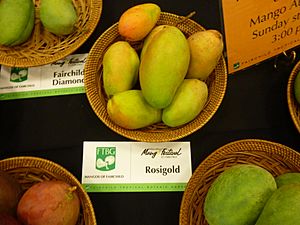Rosigold facts for kids
Quick facts for kids Mangifera 'Rosigold' |
|
|---|---|

'Rosigold' mangoes at the 2010 International Mango Festival at the Fairchild Tropical Botanic Garden in Coral Gables, Florida
|
|
| Genus | Mangifera |
| Species | Mangifera indica |
| Hybrid parentage | 'Ono' × unknown |
| Cultivar | 'Rosigold' |
| Origin | Florida, US |
The 'Rosigold' mango' (or 'Rosy Gold') is a special type of mango. It was first chosen and grown in sunny south Florida. This mango is known for ripening early in the season.
Contents
The Story of Rosigold Mango
The 'Rosigold' mango has roots in Southeast Asia. It might have grown from a seed of a "Saigon-type" mango. Experts believe it came from a mango called 'Ono'. This was found out in a study done in 2005.
Why Rosigold is Great for Home Gardens
The 'Rosigold' mango tree does not grow very tall. Because of this, it's perfect for people with smaller yards. It's also great if you want mangoes early in the year. Many people call it a "condo mango." This is because you can grow it in a pot, even on a balcony! You can buy 'Rosigold' trees from plant nurseries today.
Where Rosigold Mangoes Are Studied
'Rosigold' mango trees are part of special plant collections. You can find them at the University of Florida's Tropical Research and Education Center. They are also at the Miami-Dade Fruit and Spice Park. Both of these places are in Homestead, Florida.
What Does a Rosigold Mango Look Like?
The 'Rosigold' mango fruit is usually less than one pound. It has an oval shape and a very smooth skin. The tip of the fruit is a bit rounded. When it's ready to eat, the skin turns bright yellow. Sometimes, it also has a pretty orange-red blush.
Inside the Rosigold Mango
The inside of the mango is orange-yellow. It has a rich, sweet taste. This mango is special because it has no stringy fibers. It also has a seed that can grow more than one plant. This is called a polyembryonic seed.
When to Enjoy Rosigold Mangoes
'Rosigold' trees produce many fruits. They start to ripen in March in Florida. This makes 'Rosigold' one of the first mangoes ready to eat each year!
How the Rosigold Tree Grows
The 'Rosigold' tree stays quite small. You can keep it about 8 feet tall with regular trimming. This small size makes it easy to manage.

